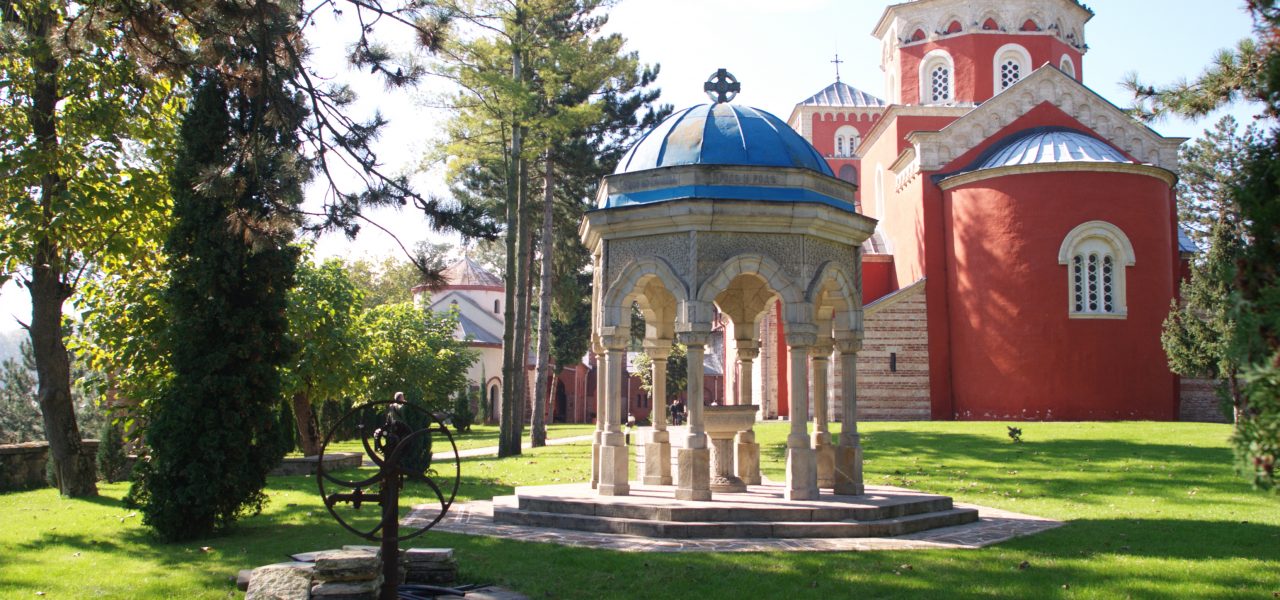INTRODUCTION
The Žiča Monastery is a Serbian Orthodox monastery near Kraljevo and Vrnjačka Banja at the exit of the canyon at the end of the river Ibar. The monastery is located on the outskirts of the village Žiča (Kraljevo). In its position as the episcopal seat of the first Serbian Exarch, it is one of the three Serbian Orthodox Monasteries with the honorary title (Carska-) Lavra next to the Studenica monastery and the Athos monastery Hilandar.
HISTORY
Serbian architecture of the 13th century is represented by large monasteries which were built according to the concepts of Byzantine monasteries. The latest archaeological researches reveal a special design to enable the life of monastic communities
The Žiča Monastery with the Church of the Savoir (Ascension of Christ) is in Central Serbia, between Kraljevo and Mataruška Spa, and was commissioned by Nemanja’s sons, Stefan the First Crowned and Sava. The time is not exactly known. It has been assumed that it was started in 1206 and most probably completed by 1220. Žiča turned into the first Seat of the Serbian Archbishoprics in 1219, when Sava Nemanjić became the first Serbian Archbishop and the Church acquired autocephaly. Sava crowned Stefan the First Crowned in Žiča as the first King of Serbia. Žiča is known as the Coronation Church, (seven Kings of Serbia were coroneted there) and the church of designation of the Serbian Archbishops.
Žiča became the first Seat of the Serbian Archbishopric in 1219, when Sava Nemanjić became the first Serbian Archbishop, and Serbia acquired autocephaly of its Church. It was decorated in frescoes after the acquisition of autonomy.
Today the Žiča monastery is a women’s monastery.
ARCHITECTURE AND FURNITURE
The Romanesque influence was reflected in the decoration of the portal and windows of this edifice as well as in the characteristic friezes of blind arcades. Scarce remnants of sculptures still clearly indicate Romanesque impact, most probably brought by the artisans of Kotor.
In Žiča (1207-1219), the founder King Stefan and his brother Sava, the first Serbian archbishop, initiated the architectural design.
The Monastery is a single-nave building with a dome right in the middle. While building this Monastery the architects allowed to lefts some space for a choir along the nave and for separate narthexes with side chapels, which are an essential part of the upcoming monuments and graves in the years afterwards of the building.
The outer narthex with the tower was erected at the request of the first archbishop as the seat of the newly established Serbian archbishopric. The construction of that part of the church was entrusted to a group of masters from the western parts, from the Romanesque area, who probably built a large outer narthex in Studenica, too – a bell tower above the entrance of the Monastery. The program worked with space and shapes – flat plastered facades with larger or smaller details as a style of Romanesque art. Large external narthexes, as a novelty in space, implied the needs of developed rituals.
The decoration of the Zica entrance has all the features of a portal theme, and it was composed with the intention of emphasizing the character of the Temple and showing examples of faith to those who enter it.
On the layer from the 13th century in both choirs two scenes have been preserved: the Crucifixion in the south and the removal from the cross in the north choir.
Very few frescoes have been preserved in today’s narthex. Other parts of the lineage of Jesse and the cycle of Baptism remain.
OPENING HOURS
Summer (April 1st – October 31st)
7.00am – 7.00pm
Winter (November 1st – March 31st)
8.00am – 4.00pm
Liturgy on Saturdays and Sundays at 7.15am
In the evening before a holiday at 5.00pm
CONTACT
Zica Monastery
36 221 Zica
Serbia
Phone: + 381 (0) 36 5816 817 and + 381 (0) 36 5816 863
We answer phone calls:
Summer (April 1st – October 31st) 11.00am – 4.00pm (every day except Sundays and holidays)
Winter (November 1st – March 31st) 10.00am – 3.00pm (every day except Sunday and holidays)
ENTRANCE FEES & GUIDED TOURS
Adults: EUR 2,00
Guided Tours on request.
TOURIST INFORMATION OFFICE
Tourism and Sport
Organisation Raška
Nemanjina 1, 36350 Raška
Phone: +381 36 738 670
+381 36 736 085
office@raska-turizam.rs
www.raska-turizam.rs


